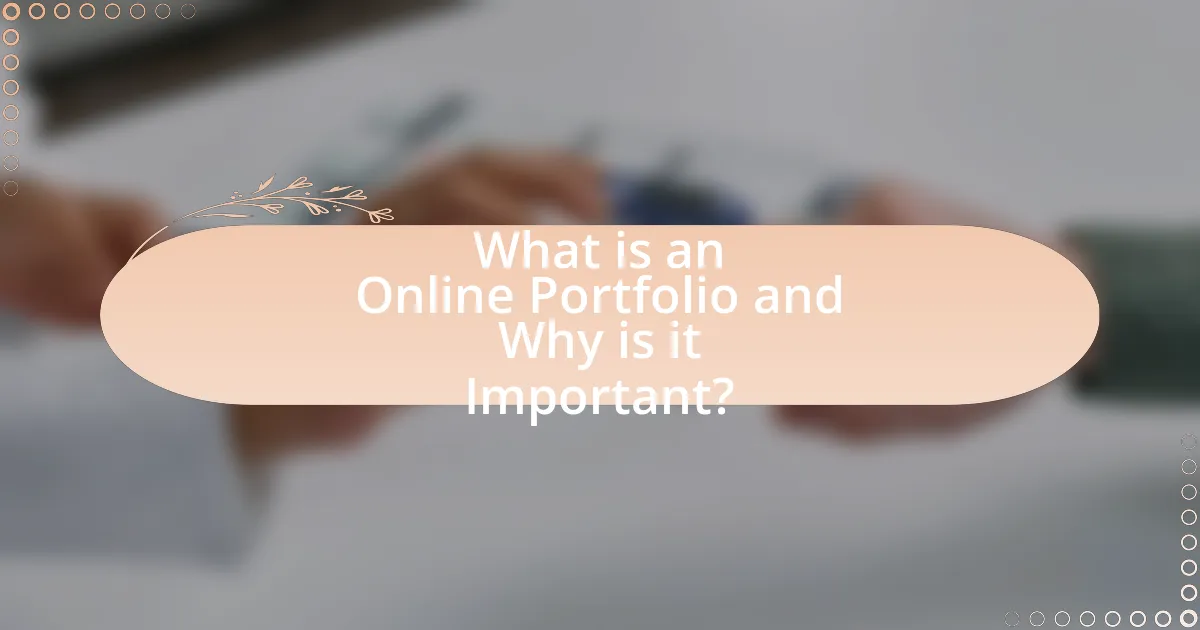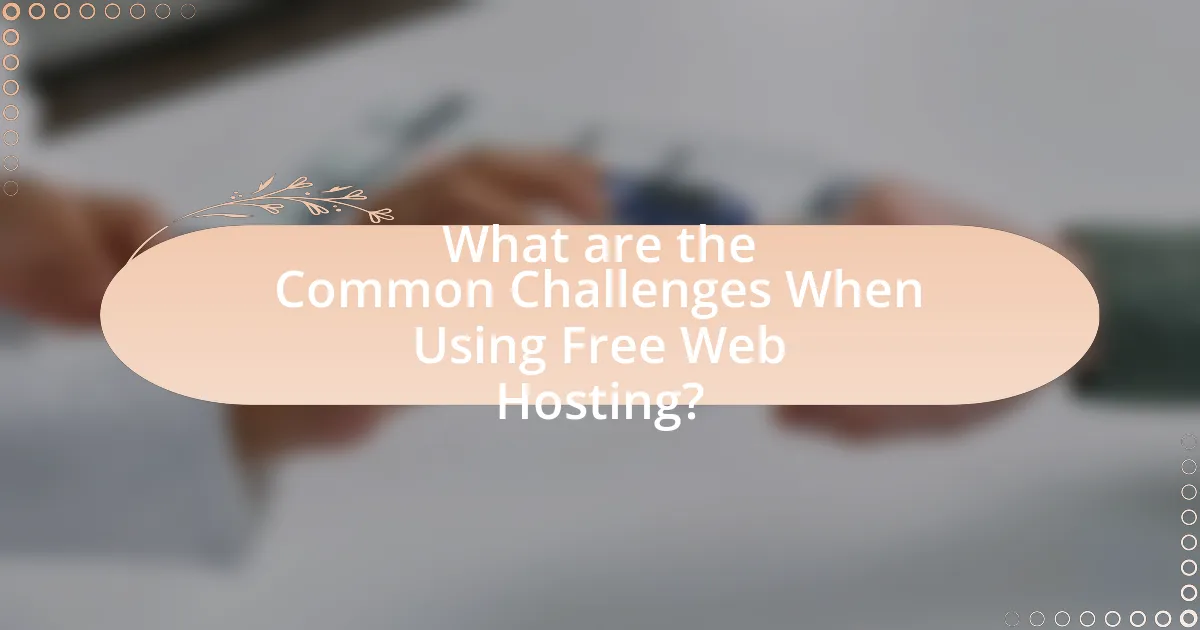Building an online portfolio using free web hosting is essential for professionals in creative fields to showcase their skills and projects effectively. This guide outlines the importance of online portfolios, their advantages over traditional formats, and the key elements to include for maximum impact. It also discusses the benefits and limitations of free web hosting services, how to choose the right platform, and best practices for designing and maintaining a portfolio. Additionally, the article addresses common challenges and technical issues associated with free hosting, providing strategies for troubleshooting and transitioning to paid services when necessary.

What is an Online Portfolio and Why is it Important?
An online portfolio is a digital collection of an individual’s work, showcasing skills, projects, and accomplishments, primarily used by professionals in creative fields. It is important because it serves as a visual resume, allowing potential employers or clients to assess a person’s capabilities and style quickly. According to a survey by CareerBuilder, 56% of employers prefer candidates with an online portfolio, highlighting its role in enhancing job prospects and professional credibility.
How does an online portfolio differ from a traditional portfolio?
An online portfolio differs from a traditional portfolio primarily in its accessibility and format. Online portfolios are hosted on the internet, allowing users to access them from anywhere at any time, while traditional portfolios are physical collections of work that require in-person viewing. Additionally, online portfolios can incorporate multimedia elements such as videos, animations, and interactive features, enhancing the presentation of work, whereas traditional portfolios are typically limited to static images and printed materials. This digital format allows for easier updates and sharing, as online portfolios can be modified instantly and shared via links, unlike traditional portfolios which require physical transportation and manual updates.
What elements should be included in an online portfolio?
An online portfolio should include a clear introduction, a showcase of work samples, a detailed resume, client testimonials, and contact information. The introduction provides context about the individual or brand, while work samples demonstrate skills and expertise relevant to the field. A detailed resume outlines professional experience and qualifications, and client testimonials add credibility by showcasing positive feedback from previous clients or employers. Finally, contact information ensures potential clients or employers can easily reach out for inquiries or opportunities. These elements collectively create a comprehensive representation of an individual’s professional capabilities.
Why is an online portfolio essential for professionals today?
An online portfolio is essential for professionals today because it serves as a dynamic showcase of skills, experiences, and accomplishments. In a digital-first world, potential employers and clients increasingly rely on online presence to assess candidates. According to a survey by CareerBuilder, 70% of employers use social media to screen candidates, highlighting the importance of a well-curated online portfolio. Furthermore, an online portfolio allows for easy updates and accessibility, enabling professionals to present their work in real-time and reach a global audience. This adaptability and visibility are crucial in competitive job markets, making an online portfolio a vital tool for career advancement.
What are the advantages of using free web hosting for an online portfolio?
Using free web hosting for an online portfolio offers several advantages, including cost-effectiveness, ease of use, and accessibility. Cost-effectiveness is a primary benefit, as it allows individuals to showcase their work without incurring expenses, making it ideal for students or those starting their careers. Ease of use is another advantage, as many free hosting platforms provide user-friendly interfaces and templates, enabling users to create and manage their portfolios without technical expertise. Accessibility is also significant; free web hosting allows portfolios to be available to a global audience, enhancing visibility and networking opportunities. These factors collectively make free web hosting a practical choice for individuals looking to establish an online presence.
How can free web hosting save costs for beginners?
Free web hosting saves costs for beginners by eliminating the need for upfront expenses associated with purchasing a hosting plan. Beginners can create and maintain their online presence without financial investment, allowing them to allocate resources to other essential areas, such as content creation or marketing. According to a survey by HostingAdvice, 70% of new website owners reported that free hosting options significantly reduced their initial costs, enabling them to focus on developing their skills and portfolios without the burden of financial commitments.
What limitations should one be aware of when using free web hosting?
Free web hosting typically comes with several limitations that users should be aware of. These limitations often include restricted storage space, which can hinder the ability to upload large files or multiple images; limited bandwidth, potentially leading to slow loading times or downtime during high traffic; and the presence of ads, which can detract from the professional appearance of an online portfolio. Additionally, free hosting services may lack customer support, making it difficult to resolve issues promptly. Security features are often minimal, increasing vulnerability to cyber threats. Lastly, users may face restrictions on custom domain names, which can affect branding and credibility.

How to Choose the Right Free Web Hosting Service?
To choose the right free web hosting service, evaluate the features, reliability, and limitations of each option. Key factors include storage space, bandwidth, uptime guarantees, and customer support. For instance, some services may offer limited storage or display ads on your site, which can affect your portfolio’s professionalism. Research shows that platforms like WordPress.com and Wix provide user-friendly interfaces and essential features for portfolio building, making them popular choices among users. Additionally, consider the scalability of the service; if you plan to grow your portfolio, select a host that allows easy upgrades to paid plans.
What features should you look for in a free web hosting provider?
When selecting a free web hosting provider, prioritize features such as storage space, bandwidth, uptime reliability, and customer support. Adequate storage space allows for the hosting of images and files essential for an online portfolio, while sufficient bandwidth ensures that visitors can access the site without delays. Uptime reliability is crucial, as a provider with a high uptime percentage (ideally above 99.9%) minimizes the risk of your site being inaccessible. Additionally, responsive customer support can assist in resolving issues quickly, enhancing the overall user experience. These features collectively contribute to a functional and effective online portfolio.
How does storage and bandwidth affect your online portfolio?
Storage and bandwidth significantly impact the performance and accessibility of your online portfolio. Adequate storage allows you to host high-quality images, videos, and documents, which are essential for showcasing your work effectively. For instance, a portfolio with limited storage may require you to compress files, potentially degrading their quality and presentation. Bandwidth, on the other hand, determines how much data can be transferred to users at any given time. Insufficient bandwidth can lead to slow loading times, which negatively affects user experience and may deter potential clients or employers. Research indicates that a one-second delay in page load time can reduce conversions by 7%, highlighting the importance of both storage and bandwidth in maintaining an engaging online portfolio.
What security measures should be considered when selecting a host?
When selecting a host, essential security measures include evaluating the provider’s data encryption protocols, firewall protections, and backup solutions. Data encryption ensures that sensitive information is protected during transmission and storage, while robust firewall protections help prevent unauthorized access to the server. Additionally, reliable backup solutions are crucial for data recovery in case of breaches or data loss. According to a 2021 report by Cybersecurity Ventures, cybercrime is projected to cost the world $10.5 trillion annually by 2025, highlighting the importance of these security measures in safeguarding online assets.
What are the most popular free web hosting platforms available?
The most popular free web hosting platforms available are WordPress.com, Wix, Weebly, and GitHub Pages. WordPress.com offers a user-friendly interface and a wide range of themes, making it suitable for blogs and portfolios. Wix provides drag-and-drop functionality and customizable templates, appealing to users seeking design flexibility. Weebly is known for its ease of use and integrated e-commerce features, while GitHub Pages is favored by developers for hosting static websites directly from GitHub repositories. These platforms are widely recognized for their reliability and user-friendly features, making them ideal for individuals looking to build an online portfolio without incurring costs.
How does each platform compare in terms of usability and features?
Each platform varies significantly in usability and features. For instance, WordPress offers a user-friendly interface with extensive customization options through plugins and themes, making it suitable for users with varying technical skills. In contrast, Wix provides a drag-and-drop builder that simplifies the design process, appealing to beginners who prioritize ease of use over advanced features.
Additionally, Squarespace is known for its visually appealing templates and integrated e-commerce capabilities, which enhance usability for creative professionals looking to showcase their work. On the other hand, GitHub Pages caters to developers, offering robust version control and customization through coding, but may present a steeper learning curve for non-technical users.
Overall, while WordPress and Wix excel in user-friendliness, Squarespace stands out for design, and GitHub Pages is tailored for developers, highlighting the diverse usability and feature sets across these platforms.
What are the pros and cons of the top free web hosting services?
The pros of the top free web hosting services include no financial cost, making them accessible for individuals and small businesses, and ease of use, often featuring user-friendly interfaces and one-click installations. These services typically provide basic features sufficient for personal websites or portfolios, such as limited storage and bandwidth, which can be adequate for low-traffic sites.
Conversely, the cons include limited resources, which can lead to slow loading times and downtime, and lack of customer support, as many free services do not offer reliable assistance. Additionally, free web hosting often comes with advertisements on the site, which can detract from the professional appearance of an online portfolio. Furthermore, users may face restrictions on domain names, typically being forced to use subdomains, which can impact branding and credibility.

How to Build Your Online Portfolio Using Free Web Hosting?
To build your online portfolio using free web hosting, select a reliable free web hosting service such as WordPress.com, Wix, or GitHub Pages. These platforms provide user-friendly interfaces and templates that allow you to showcase your work effectively. After choosing a platform, create an account and follow the setup instructions to customize your portfolio’s design and layout. Upload your projects, including images, descriptions, and links, to highlight your skills and experience. Free web hosting services often include built-in tools for SEO optimization, which can enhance your portfolio’s visibility. According to a 2021 survey by Statista, over 30% of websites are hosted on WordPress, demonstrating the popularity and reliability of such platforms for portfolio creation.
What steps are involved in setting up your online portfolio?
To set up your online portfolio, follow these steps: First, choose a free web hosting platform that suits your needs, such as WordPress, Wix, or Weebly. Next, create an account on the selected platform and select a template that aligns with your style and profession. After that, customize the template by adding your content, including your bio, work samples, and contact information. Then, organize your portfolio into sections for easy navigation. Finally, publish your portfolio and share the link on social media and professional networks to increase visibility. These steps ensure a structured and professional online presence, making it easier for potential clients or employers to view your work.
How do you register for a free web hosting account?
To register for a free web hosting account, visit a web hosting provider’s website that offers free plans, such as InfinityFree or 000webhost. After selecting the free plan, fill out the registration form with your email address and create a password. Confirm your email address through the verification link sent to your inbox. This process is standard across many providers, ensuring that users can easily access hosting services without financial commitment.
What are the best practices for designing your portfolio website?
The best practices for designing your portfolio website include ensuring a clean and intuitive layout, showcasing your best work prominently, and optimizing for mobile devices. A clean layout enhances user experience by allowing visitors to navigate easily, while prominently displaying top projects captures attention and communicates your skills effectively. Mobile optimization is crucial, as over 50% of web traffic comes from mobile devices, making it essential for accessibility and user engagement. Additionally, using high-quality images and concise descriptions can further enhance the visual appeal and clarity of your portfolio.
How can you effectively showcase your work in your online portfolio?
To effectively showcase your work in your online portfolio, prioritize high-quality visuals and clear descriptions of each project. High-quality images or videos engage viewers and provide a professional appearance, while concise descriptions help contextualize your work, explaining your role, the challenges faced, and the outcomes achieved. Research indicates that portfolios with strong visuals and clear narratives can increase viewer engagement by up to 70%, making it essential to present your work in an appealing and informative manner.
What types of content should you include to attract potential clients?
To attract potential clients, include case studies, testimonials, portfolio samples, blog posts, and informative videos. Case studies demonstrate your problem-solving abilities and successful outcomes, while testimonials provide social proof of your expertise and reliability. Portfolio samples showcase your best work, allowing clients to visualize the quality of your services. Blog posts can establish your authority in your field by sharing insights and tips, and informative videos can engage viewers and explain complex concepts effectively. These content types collectively enhance your online presence and credibility, making it easier for potential clients to trust and choose your services.
How can you optimize your portfolio for search engines?
To optimize your portfolio for search engines, focus on implementing SEO best practices such as using relevant keywords, optimizing meta tags, and ensuring mobile responsiveness. Incorporating keywords that reflect your work and expertise in titles, descriptions, and throughout the content enhances visibility. Optimizing meta tags, including title tags and meta descriptions, improves click-through rates by providing concise summaries of your portfolio’s content. Additionally, ensuring that your portfolio is mobile-friendly is crucial, as Google prioritizes mobile-optimized sites in search rankings. According to Google’s mobile-first indexing policy, sites that are not mobile-friendly may rank lower in search results, impacting visibility.

What are the Common Challenges When Using Free Web Hosting?
Common challenges when using free web hosting include limited storage and bandwidth, lack of customer support, and the presence of ads on websites. Limited storage and bandwidth can restrict the amount of content and traffic a website can handle, which is critical for an online portfolio. The absence of reliable customer support can lead to difficulties in resolving technical issues promptly, impacting website availability. Additionally, many free hosting services display ads on user websites, which can detract from the professional appearance of an online portfolio. These challenges can hinder the effectiveness and credibility of a portfolio, making it less appealing to potential clients or employers.
What technical issues might arise with free web hosting?
Free web hosting can lead to several technical issues, including limited bandwidth, unreliable uptime, and lack of customer support. Limited bandwidth may result in slow loading times or downtime during high traffic periods, negatively impacting user experience. Unreliable uptime can cause websites to be inaccessible, which is detrimental for online portfolios that require consistent availability. Additionally, the absence of customer support can hinder the resolution of technical problems, leaving users without assistance when issues arise. These factors collectively compromise the functionality and professionalism of an online portfolio.
How can you troubleshoot common problems with your portfolio site?
To troubleshoot common problems with your portfolio site, first identify the specific issue, such as slow loading times, broken links, or display errors. For slow loading times, optimize images and minimize code to enhance performance; studies show that a 1-second delay in page response can result in a 7% reduction in conversions. For broken links, use tools like Google Search Console to identify and fix them, as broken links can negatively impact user experience and SEO. For display errors, check browser compatibility and ensure that your site is responsive across devices; according to Statista, over 50% of web traffic comes from mobile devices. Regularly testing your site and utilizing analytics can help pinpoint and resolve these issues effectively.
What are the limitations of customer support with free hosting services?
Customer support with free hosting services is often limited in availability and responsiveness. Many free hosting providers offer minimal or no customer support, which can lead to delays in resolving issues. For instance, users may encounter long wait times for email responses or lack access to live chat or phone support. Additionally, the quality of support can be inconsistent, as free services may prioritize paying customers, resulting in less attention to free users. This limitation can hinder users’ ability to troubleshoot problems effectively, impacting their online portfolio’s performance and reliability.
How can you transition from free web hosting to a paid service?
To transition from free web hosting to a paid service, first select a reliable paid hosting provider that meets your needs. After choosing a provider, sign up for a hosting plan and set up your account. Next, back up your website data from the free hosting service, which typically involves exporting files and databases. Then, upload your website files to the new paid hosting account using FTP or a file manager. Finally, update your domain’s DNS settings to point to the new hosting provider, ensuring a smooth transition. This process is validated by the fact that many users successfully migrate their websites by following these steps, as documented in various web hosting guides.
What indicators suggest it’s time to upgrade your hosting plan?
Indicators that suggest it’s time to upgrade your hosting plan include consistently high website traffic, slow loading times, frequent downtime, and limited storage or bandwidth. High traffic can overwhelm a basic hosting plan, leading to performance issues; for instance, if your site experiences a surge in visitors and becomes unresponsive, it indicates the need for a more robust plan. Slow loading times, which can negatively impact user experience and SEO rankings, often arise when the current hosting cannot handle the site’s demands. Frequent downtime, which can result in lost visitors and revenue, signals that the existing plan is insufficient for your needs. Lastly, if you are nearing or exceeding your storage or bandwidth limits, it is a clear sign that an upgrade is necessary to accommodate your growing portfolio and ensure optimal performance.
How can you migrate your portfolio to a new hosting provider smoothly?
To migrate your portfolio to a new hosting provider smoothly, first, back up all your website files and databases from the current host. This ensures that you have a complete copy of your portfolio, which is crucial for a seamless transition. Next, choose a new hosting provider that meets your needs and set up your account with them. After that, upload your backed-up files and databases to the new host. Update your domain’s DNS settings to point to the new hosting provider, which may take some time to propagate. Finally, test your website on the new host to ensure everything functions correctly. This process minimizes downtime and preserves the integrity of your portfolio during the migration.
What are the best practices for maintaining your online portfolio?
The best practices for maintaining your online portfolio include regularly updating content, ensuring mobile responsiveness, optimizing for search engines, and monitoring performance analytics. Regular updates keep your portfolio relevant and showcase your latest work, which is crucial as trends and technologies evolve. Mobile responsiveness is essential, as over 50% of web traffic comes from mobile devices, making it vital for user experience. Search engine optimization (SEO) enhances visibility, allowing potential clients or employers to find your portfolio easily. Monitoring performance analytics helps identify which sections attract the most attention, enabling you to make informed adjustments. These practices collectively ensure that your online portfolio remains effective and engaging.
How often should you update your portfolio content?
You should update your portfolio content at least every six months. Regular updates ensure that your portfolio reflects your most current skills, projects, and experiences, which is crucial in a rapidly changing job market. Research indicates that professionals who maintain up-to-date portfolios are 50% more likely to attract potential employers or clients, as they demonstrate ongoing engagement and growth in their field.
What strategies can you use to keep your portfolio relevant and engaging?
To keep your portfolio relevant and engaging, regularly update your content and showcase recent projects. This strategy ensures that your portfolio reflects your current skills and interests, making it more appealing to potential clients or employers. For instance, incorporating new work every few months can demonstrate growth and adaptability in your field. Additionally, utilizing analytics tools can provide insights into visitor behavior, allowing you to tailor your content to what resonates most with your audience. Engaging with your audience through blog posts or social media links can also enhance interaction and keep your portfolio dynamic.